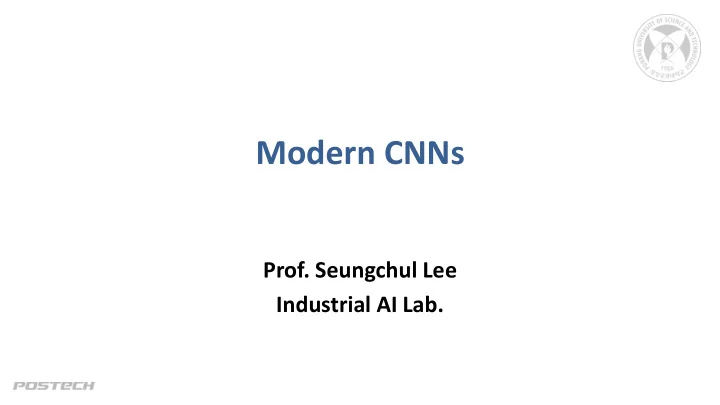

Modern CNNs Prof. Seungchul Lee Industrial AI Lab.
ImageNet • Human performance = 5.1 % from Kaiming He slides "Deep residual learning for image recognition," ICML, 2016. 2
ImageNet 3
LeNet • CNN = Convolutional Neural Networks = ConvNet • LeCun, Y., Bottou, L., Bengio, Y., and Haffner, P. (1998). Gradient-based learning applied to document recognition. • All are still the basic components of modern ConvNets! Yann LeCun 4
AlexNet • Simplified version of Krizhevsky, Alex, Sutskever, and Hinton. "Imagenet classification with deep convolutional neural networks." NIPS 2012 • LeNet-style backbone, plus: – ReLU [Nair & Hinton 2010] • “ RevoLUtion of deep learning”* • Accelerate training – Dropout [Hinton et al 2012] • In-network ensembling • Reduce overfitting – Data augmentation • Label-preserving transformation • Reduce overfitting 5
VGG-16/19 • Simonyan, Karen, and Zisserman. "Very deep convolutional networks for large-scale image recognition." (2014) • Simply “Very Deep”! – Modularized design • 3x3 Conv as the module • Stack the same module • Same computation for each module – Stage-wise training • VGG-11 → VGG-13 → VGG-16 • We need a better initialization… 6
GoogleNet/Inception • Multiple branches – e.g., 1x1, 3x3, 5x5, pool • Shortcuts – stand-alone 1x1, merged by concatenation • Bottleneck Inception module – Reduce dim by 1x1 before expensive 3x3/5x5 conv 7
ResNet (Deep Residual Learning) • He, Kaiming, et al. “Deep residual learning for image recognition .” CVPR. 2016. • Plane net 𝐼(𝑦) is any desired mapping, hope the small subnet fit 𝐼(𝑦) 8
ResNet (Deep Residual Learning) • He, Kaiming, et al. "Deep residual learning for image recognition." CVPR. 2016. • Residual net • Skip connection 𝐼(𝑦) is any desired mapping, hope the small subnet fit 𝐼 𝑦 hope the small subnet fit 𝐺(𝑦) Let 𝐼 𝑦 = 𝐺 𝑦 + 𝑦 - A direct connection between 2 non-consecutive layers - No gradient vanishing 9
ResNet (Deep Residual Learning) • Parameters are optimized to learn a residual, that is the difference between the value before the block and the one needed after. • 𝐺(𝑦) is a residual mapping w.r.t. identity • If identity were optimal, easy to set weights as 0 • If optimal mapping is closer to identity, easier to find small fluctuations 10
Skip Connection • A skip connection is a connection that bypasses at least one layer. • Here, it is often used to transfer local information by concatenating or summing feature maps from the downsampling path with feature maps from the upsampling path. – Will see it at FCN later – Merging features from various resolution levels helps combining context information with spatial information. 11
Residual Net 12
DensNets • Densely Connected Convolutional Networks Huang, Gao, et al., “Densely connected convolutional networks” 13 Proceedings of the IEEE conference on computer vision and pattern recognition. Vol. 1. No. 2. 2017.
U-Net • The U-Net owes its name to its symmetric shape – better segmentation in medical imaging Ronneberger, Olaf; Fischer, Philipp; Brox, Thomas (2015), 14 “U - Net: Convolutional Networks for Biomedical Image Segmentation.” arXiv:1505.04597
Modern CNNs • LeNet • AlexNet • VGG • GoolgeNet/Inception • ResNet • DensNet • U-Net 15
Recommend
More recommend